GERSDORFF, Hans von (c. 1455-1529). Feldtbuch der wundartzney . [Augsburg: Heinrich Steiner, ?after 1530].
GERSDORFF, Hans von (c. 1455-1529). Feldtbuch der wundartzney . [Augsburg: Heinrich Steiner, ?after 1530]. 2° (280 x 195mm). Collation: a 4 A-O 6. Fraktur type, double column. Folding full-sheet woodcut of a skeleton with descriptive text, 25 woodcuts, attributed in part to Hans Wächtlin, most full-page and including one repeat, woodcut historiated and decorated initials. (Light marginal dampstain at lower hinge, occasional light spotting.) Contemporary German white kidskin over thin pasteboard, panelled in blind with trellis and floral roll tools and fillets, missing two fore-edge ties (lacking backstrip, rubbed, worn at extremities); modern cloth box. Provenance : [Johann Jakob Fugger (1516-75; title and pressmark [?Ins.4.N.15] written by Hieronymus Wolf on upper cover, now erased), his library purchased in 1571 by:] -- Albrecht V, Duke of Bavaria (bookplate) -- Munich, Royal Library (cancelled stamp). RARE EDITION OF GERSDORFF'S POPULAR AND INFLUENTIAL SURGICAL MANUAL FROM THE FUGGER LIBRARY. Fugger, a member of the Augsburg banking dynasty, was known as the richest and most learned man in Germany, and assembled an extensive library, many of whose classical texts he had bound by one Venetian shop, now called the Fugger Binder. A military surgeon with extensive practical experience, Gersdorff introduced new and sound practices for the treatment of wounds and amputations. His Feldbuch provides a summary of human anatomy derived from old Arabic writings, Guy de Chauliac, and other sources; a guide to the surgical treatment of wounds; the treatment of leprosy; and provides Latin-German glosses of medical vocabulary. It went through a dozen editions, including translations, in its first century, and was incorporated into other medical works of the period. The vivid woodcuts of surgical instruments and procedure mark a high point of medical illustration. Gersdorff's was the first printed picture of an amputation, and several illustrations, such as of the ambe , became standard in subsequent German surgical texts. The full-sheet anatomical skeleton existed in its own right as a broadside print and is often missing. Here it is identical to that printed for Schott's 1517 first edition of the work, but omits the date in the upper-left corner and Schott's printer's mark at the bottom. Another full-sheet woodcut of a visceral manekin was included in some editions of the Feldbuch . Josef Benzing identified Steiner as the printer of this edition in a private communication of 4 June 1964, and located only 4 other copies. Steiner issued a signed edition in 1542 in which the woodcuts were replaced by copies. Cf. R. Herrlinger, History of Medical Illustration , pp. 140-43; W. LeFanu, Notable Medical Books from the Lilly Library , p. 19; Choulant-Frank, History and Bibliography of Anatomic Illustration , pp. 162-66; Garrison-Morton, 5th ed., 5560 (1517 edition). This edition not in Durling/NLM; Waller; Wellcome Library; the British Library; Cat. of Medical Books in Manchester University Library ; etc. VD-16 G-1621.
GERSDORFF, Hans von (c. 1455-1529). Feldtbuch der wundartzney . [Augsburg: Heinrich Steiner, ?after 1530].
GERSDORFF, Hans von (c. 1455-1529). Feldtbuch der wundartzney . [Augsburg: Heinrich Steiner, ?after 1530]. 2° (280 x 195mm). Collation: a 4 A-O 6. Fraktur type, double column. Folding full-sheet woodcut of a skeleton with descriptive text, 25 woodcuts, attributed in part to Hans Wächtlin, most full-page and including one repeat, woodcut historiated and decorated initials. (Light marginal dampstain at lower hinge, occasional light spotting.) Contemporary German white kidskin over thin pasteboard, panelled in blind with trellis and floral roll tools and fillets, missing two fore-edge ties (lacking backstrip, rubbed, worn at extremities); modern cloth box. Provenance : [Johann Jakob Fugger (1516-75; title and pressmark [?Ins.4.N.15] written by Hieronymus Wolf on upper cover, now erased), his library purchased in 1571 by:] -- Albrecht V, Duke of Bavaria (bookplate) -- Munich, Royal Library (cancelled stamp). RARE EDITION OF GERSDORFF'S POPULAR AND INFLUENTIAL SURGICAL MANUAL FROM THE FUGGER LIBRARY. Fugger, a member of the Augsburg banking dynasty, was known as the richest and most learned man in Germany, and assembled an extensive library, many of whose classical texts he had bound by one Venetian shop, now called the Fugger Binder. A military surgeon with extensive practical experience, Gersdorff introduced new and sound practices for the treatment of wounds and amputations. His Feldbuch provides a summary of human anatomy derived from old Arabic writings, Guy de Chauliac, and other sources; a guide to the surgical treatment of wounds; the treatment of leprosy; and provides Latin-German glosses of medical vocabulary. It went through a dozen editions, including translations, in its first century, and was incorporated into other medical works of the period. The vivid woodcuts of surgical instruments and procedure mark a high point of medical illustration. Gersdorff's was the first printed picture of an amputation, and several illustrations, such as of the ambe , became standard in subsequent German surgical texts. The full-sheet anatomical skeleton existed in its own right as a broadside print and is often missing. Here it is identical to that printed for Schott's 1517 first edition of the work, but omits the date in the upper-left corner and Schott's printer's mark at the bottom. Another full-sheet woodcut of a visceral manekin was included in some editions of the Feldbuch . Josef Benzing identified Steiner as the printer of this edition in a private communication of 4 June 1964, and located only 4 other copies. Steiner issued a signed edition in 1542 in which the woodcuts were replaced by copies. Cf. R. Herrlinger, History of Medical Illustration , pp. 140-43; W. LeFanu, Notable Medical Books from the Lilly Library , p. 19; Choulant-Frank, History and Bibliography of Anatomic Illustration , pp. 162-66; Garrison-Morton, 5th ed., 5560 (1517 edition). This edition not in Durling/NLM; Waller; Wellcome Library; the British Library; Cat. of Medical Books in Manchester University Library ; etc. VD-16 G-1621.

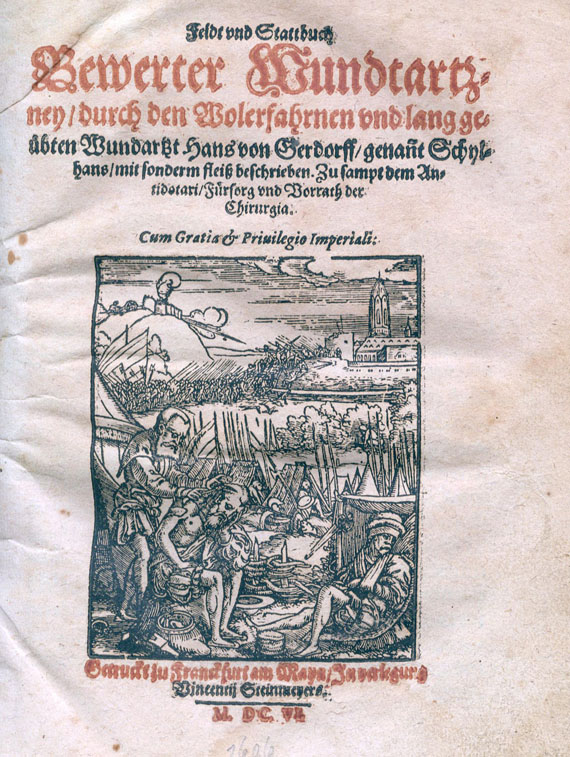
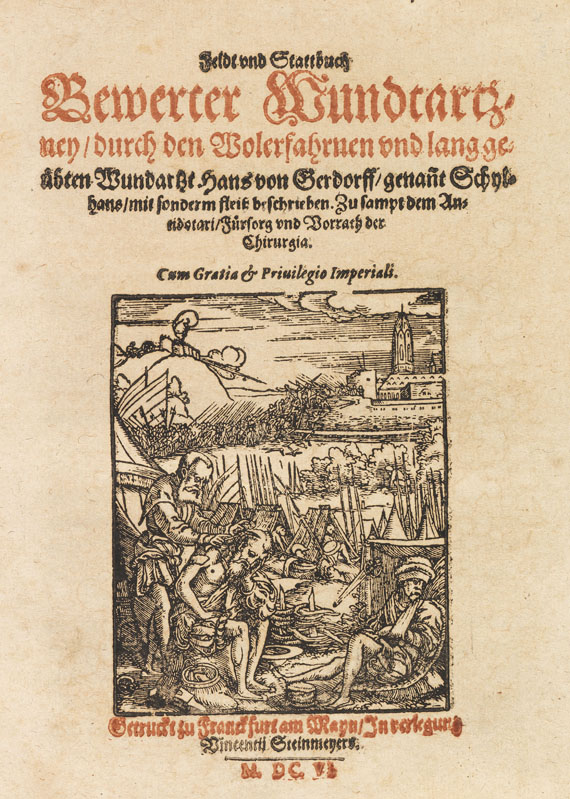

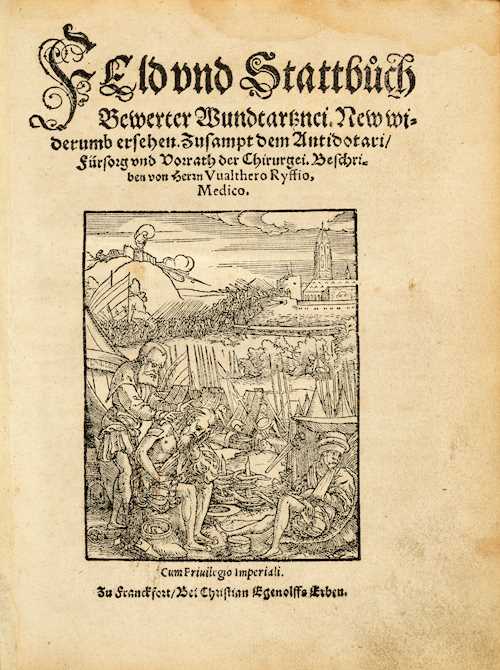

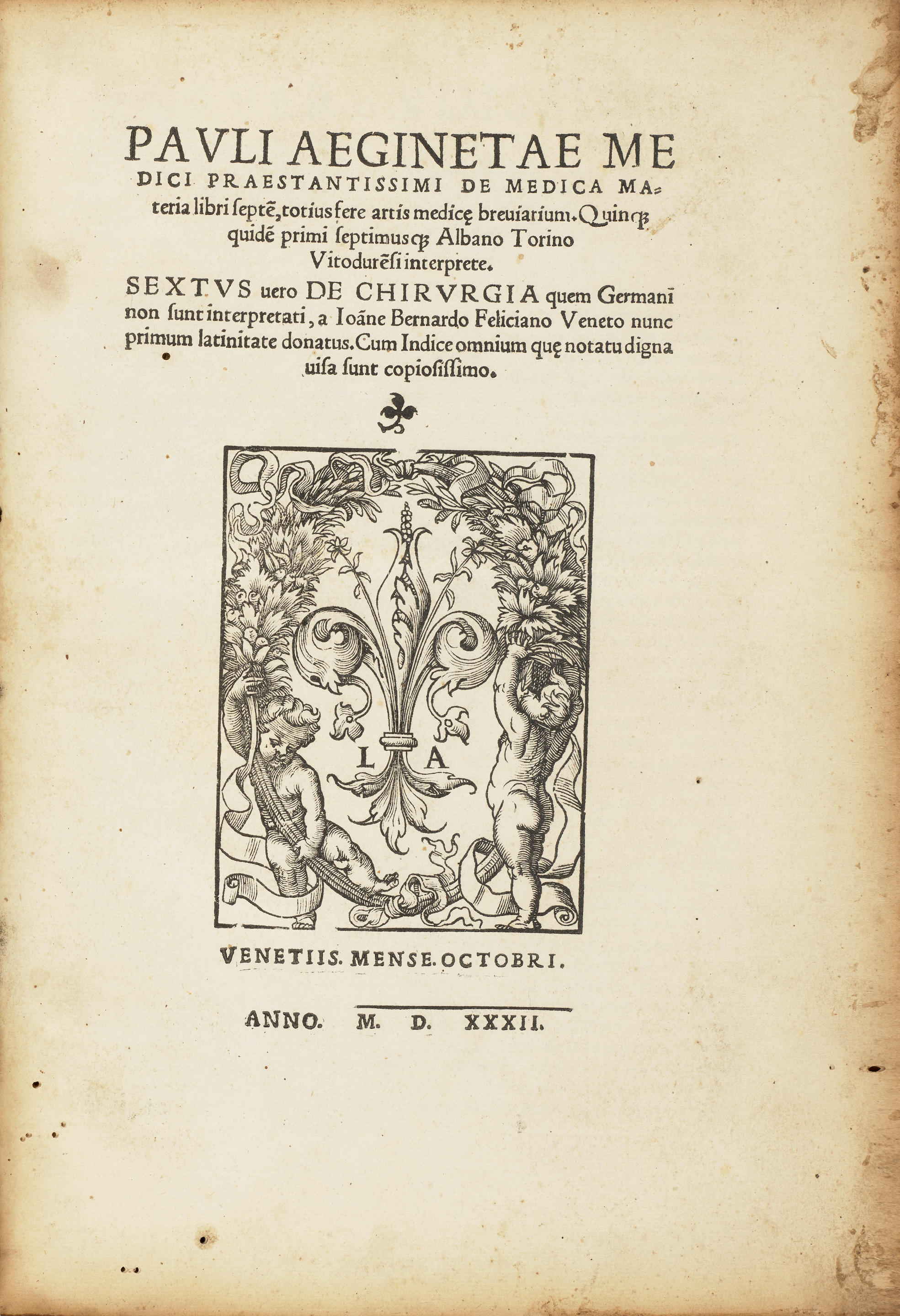





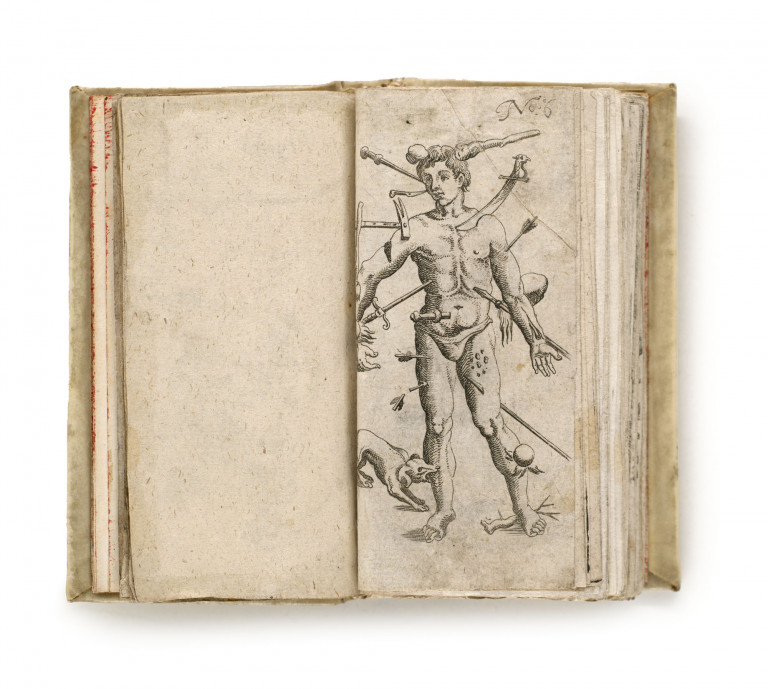

Try LotSearch and its premium features for 7 days - without any costs!
Be notified automatically about new items in upcoming auctions.
Create an alert